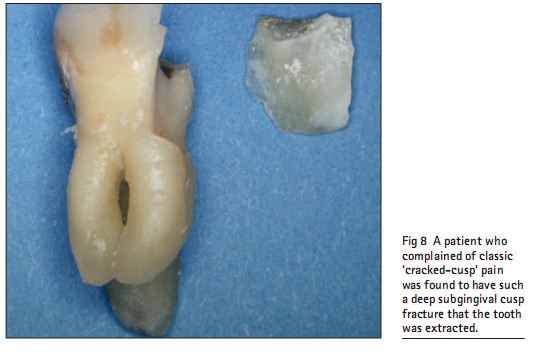Crazing of the enamel surface is a common finding on teeth as a consequence of function, but on occasion it may indicate a cracked tooth. If the crack runs deep into dentine and is therefore a fracture, chewing may be painful. Initially, this may not be of sufficient intensity for the patient to seek treatment. However, once the fracture line communicates with the pulp, pulpitis will ensue. A quiescent period of several months may follow before any further symptoms develop. The patient may present with a whole range of bizarre symptoms, many of which are similar to those of irreversible pulpitis:
Pain on chewing. Sensitivity to hot and cold fluids. Pain which is difficult to localize. Pain referred along to the areas served by the
fifth cranial nerve. Acute pulpal pain. Alveolar abscess.
Diagnosis can be difficult and much depends on the plane of the fracture line and its site on the tooth. Radiographs are unlikely to reveal a fracture unless it runs in a buccolingual plane. A fibre-optic light is a useful aid as it will often reveal the position of the fracture. One diagnostic test is to ask the patient to bite on a piece of folded rubber dam. Care must be exercised as this test may extend the fracture line. The extent of the fracture line and its site will decide whether the tooth can be saved or not. If it is a vertical fracture, involves the root canal system and extends below the level of the alveolar crest, then the prognosis is poor and extraction is indicated (Fig. 8).

However, if the fracture line is horizontal or diagonal and superficial to the alveolar crest, then the prognosis may be better.